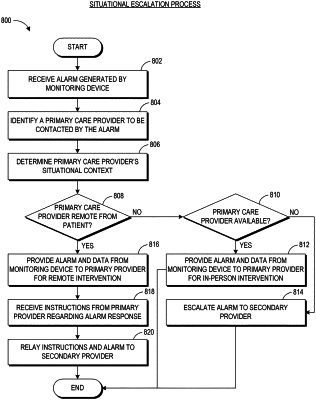| CPC G16H 40/67 (2018.01) [A61B 5/0022 (2013.01); G08B 21/02 (2013.01); G08B 29/20 (2013.01); H04L 45/70 (2013.01); G08B 25/005 (2013.01); G08B 29/16 (2013.01)] | 20 Claims |

|
1. A system for remotely escalating a patient monitoring alarm to provide a continuum of care to a patient after discharge from a hospital, the system comprising:
a memory comprising processor-executable instructions stored thereon, the processor-executable instructions pertaining to alarm escalation; and
a hardware processor configured to execute the processor-executable instructions pertaining to alarm escalation in response to remotely receiving an alarm and data from a patient monitoring device based on at least one physiological parameter of the patient, the patient monitoring device being assigned to the patient in response to the patient being admitted to the hospital, the hardware processor configured to output an alarm profile template matching attributes of the patient to a clinician and transmit customized alarm settings for the patient to the patient monitoring device in response to acceptance of the alarm profile template by the clinician, wherein the hardware processor is further configured to:
designate, based on data stored in the memory, first and second care providers who have been previously associated with the patient in the memory, wherein the first care provider is a primary care provider of the patient and the second care provider is a non-primary care provider of the patient;
electronically determine a situational context of the first care provider;
in response to determining the situation context of the first care provider indicates the first care provider is available and local to the patient, transmit the alarm to the first care provider for possible in-person intervention;
in response to determining the situational context of the first care provider indicates the first care provider is available but located remote from the patient, and that the second care provider is local to the patient:
transmit, to the first care provider, the alarm and data received from the patient monitoring device for interaction with the patient via telepresence technologies;
electronically receive a recommended course of action from the first care provider regarding the alarm based on the interaction with the patient via telepresence technologies; and
escalate the alarm by transmitting the recommended course of action and the alarm to the second care provider; and
in response to determining the situational context of the first care provider indicates that the first care provider is unavailable and that the second care provider is local to the patient, automatically escalate the alarm to the second care provider by transmitting the alarm to the second care provider for possible in-person intervention.
|